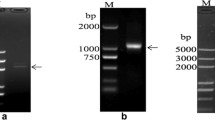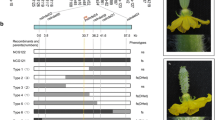Abstract
Carrot seeds normally have surface spines. The availability of a spineless mutant would be agronomically beneficial, eliminating the current efforts to remove those spines pre-sowing. Furthermore, the identification of spine-specific genes would provide insights into spine development in wild-type carrot seed. This effort could be facilitated through the use of an annealing control primer (ACP) system. Here, we employed a new and accurate reverse transcriptionpolymerase chain reaction (RT-PCR) that involves ACPs for identifying genes of interest. With these techniques, 11 expressed sequence tags (ESTs) were obtained for cloning and sequencing the genes that are differentially expressed in wild-type spiny seeds, but not in the spineless mutant. In all, 7 cDNAs exhibited significant sequence similarity with known genes from other species. These included cell wall-associated hydrolase, tail fiber assembly protein, transcriptional regulatory protein, berberine bridge enzyme, S-adenosyl methionine synthase, transketolase, and phenylalanyl t-RNA synthetase beta chain. Four other cDNA sequences had no significant identities with known genes. As revealed by RT-PCR, these genes regulate spine formation during the developmental stage. Our results suggest that PCR-based differential display RT-PCR techniques are a very useful tool for identifying spine-specific genes from carrot seeds.
Similar content being viewed by others
Literature cited
Broun P (2005) Transcriptional control of flavonoid biosynthesis: A complex network of conserved regulators involved in multiple aspects of differentiation inArabidopsis. Curr Opin Plant Biol8: 272–279
Choi K, Hong C, Kim W (2002) Isolation and characterization of drought-induced cDNA clones from hot pepper (Capsicum annuum). J Plant Biol45: 212–218
Cui XS, Shin MR, Lee KA, Kim NH (2005) Identification of differentially expressed genes in murine embryos at blastocyst stage using annealing control primer system. Mol Reprod Dev70: 278–287
Gallardo K, Job C, Groot SP, Puype M, Demol H, Vandekerckhove J, Job D (2002) Importance of methionine biosynthesis forArabidopsis seed germination and seedling growth. Physiol Plant116: 238–247
Gowri G, Bugos RC, Campbell WH, Maxwell CA, Dixon RA (1991) Stress responses in Alfalfa (Medicago sativa L.): X. Molecular cloning and expression of S-adenosyl-L-methionine: Caffeic acid 3-O-methyltransferase, a key enzyme of lignin biosynthesis. Plant Physiol97: 7–14
Harding SA, Jiang H, Lee MJ, Casado FL, Lin HW, Tsai CJ (2005) Functional genomics analysis of foliar condensed tannin and phenolic glycoside regulation in natural cottonwood hybrids. Tree Physiol25: 1475–1486
Hwang IT, Kim YJ, Kim SH, Kwak CI, Gu YY, Chun JY (2003) Annealing control primer system for improving specificity of PCR amplification. Bio Techniques35: 1180–1184
Hwang KC, Cui XS, Park SP, Shin MR, Park SY, Kim EY, im NH (2004) Identification of differentially regulated genes in bovine blastocysts using an annealing control primer system. Mol Reprod Dev69: 43–51
Hwang KC, Lee HY, Cui SS, Kim JH, Kim NH (2005) Identification of Maternal mRNAs in porcine parthenotes at the 2-cell stage: A comparison with the blastocyst stage. Mol Reprod Dev70: 314–323
Kim HJ, Triplett BA (2004) Characterization ofGhRac1 GTPase expressed in developing cotton (Gossypium hirsutum L.) fibers. Biochim Biophys Acta1679: 214–221
Kim YJ, Kwak CI, Gu YY, Hwang IT, Chun JY (2004) Annealing control primer system for identification of differentially expressed genes on agarose gels. BioTechniques36: 424–426
Oh C, Lee H, Kim H, An C (2004) Isolation and characterization of root nodule-specific cysteine proteinase cDNA from soybean. J Plant Biol47: 216–220
Park SU, Johnson AG, Penzes-Yost C, Facchini PJ (1999) Analysis of promoters from tyrosine/dihydrophenylalanine decarboxylase and berberine bridge enzyme genes involved in benzylisoquinoline alkaline biosynthesis in opium poppy. Plant Mol Biol40: 121–131
Park Y (1998) A novel carrot mutant, spineless seed,In Umbelliferae Improvement Newsletter, Vol 8. Vegetable Crops Research Unit, USDA Agricultural Research Service, Department of Horticulture, Wisconsin, pp 5–7
Park Y, Cho MS, Kim YS, Park SG (2002) A promising carrot mutant, spineless seeds. J Kor Soc Hort Sci43: 707–709
The Arabidopsis Genome Initiative (2000) Analysis of the genome sequence of the flowering plantArabidopsis thaliana. Nature408: 796–815
Whetten RW, Sun YH, Zhang YZ, Sederoff R (2001) Functional genomics and cell wall biosynthesis in loblolly pine. Plant Mol Biol47: 275–291
Author information
Authors and Affiliations
Corresponding author
Rights and permissions
About this article
Cite this article
Park, JS., Kim, I.S., Cho, M.S. et al. Identification of differentially expressed genes involved in spine formation on seeds ofDaucus carota L. (carrot), using annealing control primer (ACP) system. J. Plant Biol. 49, 133–140 (2006). https://doi.org/10.1007/BF03031009
Received:
Accepted:
Issue Date:
DOI: https://doi.org/10.1007/BF03031009




